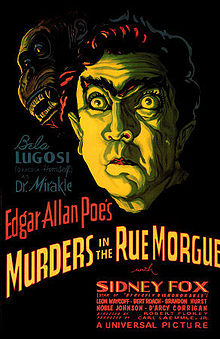 A 1932 Bela Lugosi chiller notable for highly expressionistic visual design and shocking-for-its-time violence. MURDERS IN THE RUE MORGUE, one of the standout American horror movies of its era, is credited as an adaptation of Edgar Allan Poe’s immortal tale “The Murders in the Rue Morgue,” but in fact the two have little in common. The film is better viewed as one of the many variants on Poe’s classic that have appeared over the years, including Clive Barker’s witty and perverse story “New Murders in the Rue Morgue” and a 1971 remake of the present film, which incorporates elements from THE PHANTOM OF THE OPERA.
A 1932 Bela Lugosi chiller notable for highly expressionistic visual design and shocking-for-its-time violence. MURDERS IN THE RUE MORGUE, one of the standout American horror movies of its era, is credited as an adaptation of Edgar Allan Poe’s immortal tale “The Murders in the Rue Morgue,” but in fact the two have little in common. The film is better viewed as one of the many variants on Poe’s classic that have appeared over the years, including Clive Barker’s witty and perverse story “New Murders in the Rue Morgue” and a 1971 remake of the present film, which incorporates elements from THE PHANTOM OF THE OPERA.
At a carnival the enthusiastic Dr. Mirakle presents a leering crowd with an apparent half man-half ape, and also the creature’s “parent:” a caged ape that attacks a woman patron. Later that night Dr. Mirakle heads out in his coach and picks up a young streetwalker. He takes the unfortunate woman back to his home, crucifies her and draws some of her blood—looking at that blood under a microscope, however, Mirakle finds it “rotten,” apparently due to the gal’s sinful nature. He retaliates by injecting her with gorilla’s blood, which kills her. The none-too-good doctor is then forced to find another woman for his experiment, which is intended to conclusively prove the linkage between human and ape.
Following this a couple morgue attendants examine the murdered woman’s corpse, and determine that she died under suspicious circumstances—and that her death parallels that of another young woman (one of Mirakle’s previous victims) in many respects.
For his latest victim Mirakle selects a pretty young woman. He tries to lure her to his carnival but the gal’s boyfriend shows up in her place, foiling Mirakle’s plans. He’s not about to be deterred, however, and sends his pet gorilla to snatch the woman from her apartment. But the cops are onto him, and race to save the woman. Will they succeed?
What immediately strikes one about this movie are the stunningly textured black-and-white visuals. The artfully distorted set design and shadowy photography are redolent of German expressionism—specifically the type seen in THE CABINET OF DR. CALIGARI (1920)—while also foreshadowing the look of the American film noirs of the 1940s. No wonder: cinematographer Karl Freund also photographed expressionist classics like THE GOLEM (1920) and METROPOLIS (1927), as well as Tod Browning’s DRACULA (1931). The level of onscreen violence is also startling for a film made in 1932, in particular the early crucifixion.
The narrative, unfortunately, isn’t nearly as impressive. For starters, it reveals immediately who the murderer is, which lessens the impact of the detective work so integral to Poe’s original story. The sound recording also leaves much to be desired, and the lack of music feels quite odd these days; the film, keep in mind, was made near the beginning of the sound era.
Again, though, the visuals are wondrous, and the incomparable Bela Lugosi is at his leering and seductive best here.
Vital Statistics
MURDERS IN THE RUE MORGUE
Universal Pictures
Director: Robert Florey
Producer: Carl Laemmle, Jr.
Screenplay: Robert Florey, Tom Reed, Dale van Every, John Huston
(Loosely based on a story by Edgar Allen Poe)
Cinematography: Karl Freund
Editing: Milton Carruth
Cast: Bela Lugosi, Sidney Fox, Leon Ames, Bert Roach, Betty Ross Clarke, Brandon Hurst, D’Arcy Corrigan, Nobel Johnson, Arlene Francis
